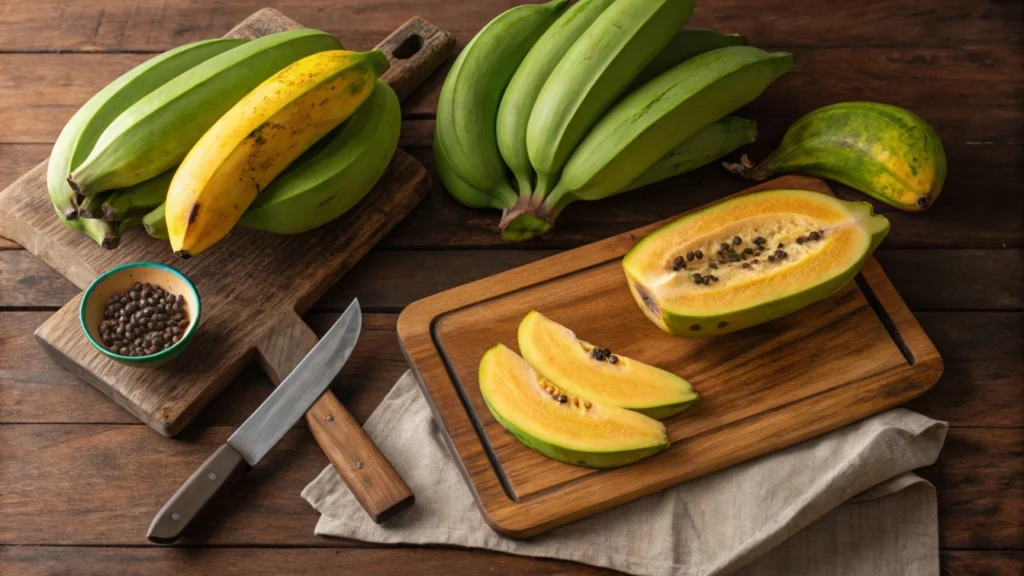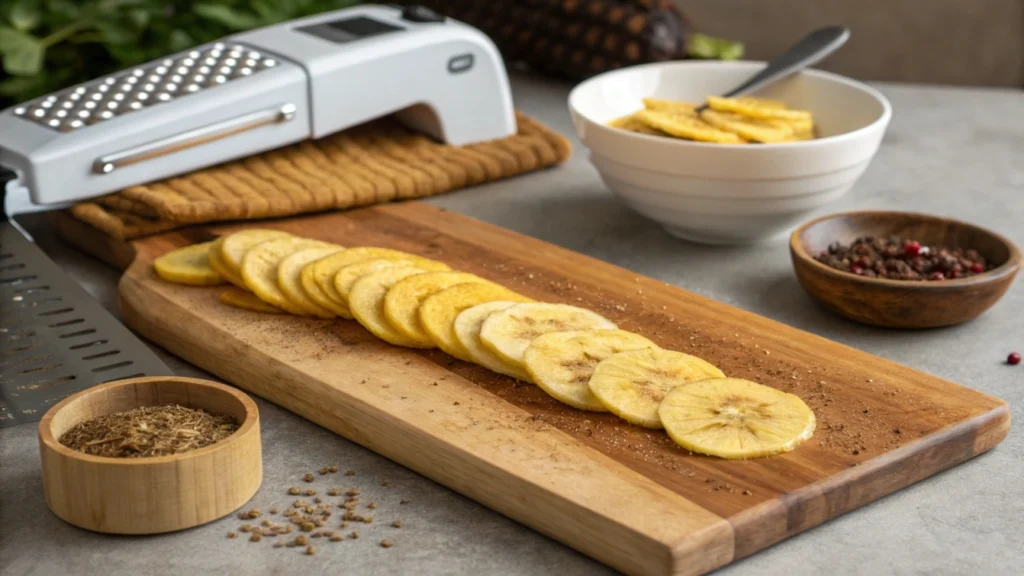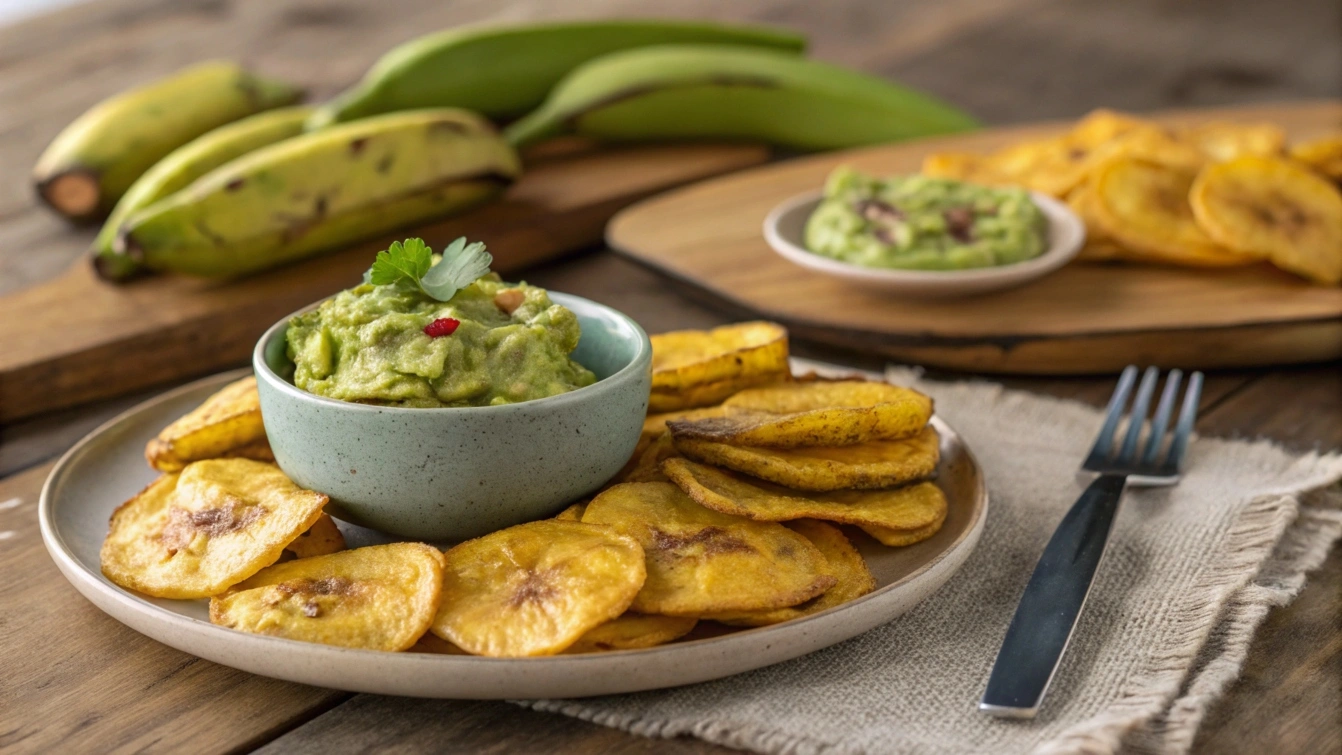Who doesn’t love a crunchy, delicious snack that’s easy to make and versatile enough to suit any occasion? Plantain chips fit the bill perfectly. These golden slices of fried or baked goodness are a popular treat enjoyed in many parts of the world, especially in the Caribbean, Latin America, and Africa. They are the perfect balance of savory and sweet, depending on how you prepare them. Whether you need a quick snack, a party appetizer, or a side dish, plantain chips never disappoint.
In this guide, we’ll dive deep into everything you need to know about making plantain chips at home from selecting the right plantains to mastering the perfect crunch. Whether you prefer them fried, baked, or air-fried, this recipe is for you. Let’s get started!
What Are Plantain Chips?
Difference Between Plantains and Bananas
Before diving into the recipe, let’s clear up a common misconception: plantains are not the same as bananas. Although they look similar, plantains are starchier and less sweet than bananas, making them an excellent choice for savory snacks like chips. They also come in different stages of ripeness green (unripe), yellow (ripe), and black (overripe) which influence the flavor and texture of the chips.
Nutritional Benefits of Plantains
Plantains are a powerhouse of nutrients. They are rich in fiber, vitamins A, C, and B6, and minerals like potassium and magnesium. Plus, they’re naturally gluten-free and can be prepared without added sugars, making them a healthier alternative to traditional potato chips.
Types of Plantain Chips
Sweet Plantain Chips
Sweet plantain chips are made using ripe plantains. These chips have a caramelized, mildly sweet flavor that pairs wonderfully with dips like guacamole or honey mustard.
Savory Plantain Chips
For a more traditional flavor, savory plantain chips are made with green plantains. These chips are crispy and salty, resembling the texture of potato chips but with a unique twist.
Baked vs. Fried Plantain Chips
While fried plantain chips are undeniably crispy and indulgent, baked plantain chips are a healthier alternative. They are lower in fat and calories but still satisfy your crunchy cravings.
Choosing the Right Plantains
The key to making perfect plantain chips lies in choosing the right type of plantains. The ripeness of the plantains will determine the flavor, texture, and cooking method.

Green vs. Ripe Plantains
- Green Plantains (Unripe)
- Best for savory chips.
- Firm texture, making them easier to slice thinly.
- Produces crispy, salty chips similar to potato chips.
- Ripe Plantains (Yellow)
- Slightly sweet flavor.
- Softer texture, requiring careful handling when slicing.
- Chips are less crispy but caramelize beautifully when fried or baked.
- Overripe Plantains (Black)
- Not ideal for chips due to their mushy texture.
- Better suited for desserts or fritters.
Tips for Selecting the Best Plantains
- Look for plantains that are blemish-free and firm to the touch.
- Avoid plantains with cracks or soft spots, as they may be overripe.
- For longer shelf life, buy green plantains and let them ripen at home.
Ingredients Needed
Making plantain chips requires only a few basic ingredients. Depending on your preference, you can keep it simple or add a creative twist with seasonings.
Core Ingredients
- Plantains (Green for savory or yellow for sweet): 2-3 large plantains.
- Cooking Oil (for frying or baking): Coconut oil, vegetable oil, or olive oil.
- Salt: To taste.
Optional Flavor Additions
- Spices: Paprika, cayenne pepper, garlic powder, or chili powder for savory chips.
- Sweeteners: A light sprinkle of cinnamon or brown sugar for sweet chips.
- Herbs: Dried oregano or parsley for a herby twist.
- Dips: Guacamole, hummus, or salsa for serving.
Essential Tools and Equipment
To ensure your plantain chips turn out perfectly crispy and golden, it’s important to use the right tools. Here’s what you’ll need:
Kitchen Tools for Perfect Plantain Chips
- Sharp Knife or Mandoline Slicer
- A sharp knife works well for thin, even slices.
- A mandoline slicer is ideal for consistent thickness, which is crucial for even cooking.
- Cutting Board
- Use a sturdy cutting board to safely slice the plantains.
- Mixing Bowl
- For tossing the plantain slices with oil and seasonings.
- Frying Pan or Deep Fryer (for frying method)
- A deep frying pan or skillet ensures even frying.
- Alternatively, an air fryer or oven can be used for healthier options.
- Tongs or Slotted Spoon
- To flip or remove chips from the oil without breaking them.
- Paper Towels or Cooling Rack
- For draining excess oil after frying.
- Baking Sheet and Parchment Paper (for baking method)
- Prevents chips from sticking during baking.
Step-by-Step Recipe Guide
Let’s get to the heart of the process: preparing your delicious plantain chips. Here’s a foolproof guide to making them crispy and flavorful.

Preparing the Plantains
- Wash the plantains thoroughly to remove any dirt.
- Using a knife, slice off both ends of the plantain.
- Make a shallow cut along the length of the peel, then gently remove the skin by hand.
- Ensure the plantains are dry before slicing to avoid oil splatter during frying.
Cutting Techniques for Even Slices
- Use a sharp knife or mandoline slicer to cut the plantains into thin, even slices.
- Aim for a thickness of 1/8 inch for ultra-crispy chips.
- Slice diagonally for longer chips or straight across for round chips.
Seasoning and Marinating
- Place the plantain slices in a mixing bowl.
- Add 1-2 tablespoons of oil and toss to coat evenly.
- Sprinkle with salt and any desired spices (e.g., paprika, garlic powder, cinnamon).
Cooking Instructions: Frying Method
- Heat vegetable or coconut oil in a frying pan over medium heat.
- The oil should be about 375°F (190°C) for optimal frying.
- Add plantain slices in batches to avoid overcrowding the pan.
- Fry each batch for 2-3 minutes, flipping halfway until golden and crispy.
- Remove with a slotted spoon and drain on paper towels or a cooling rack.
Cooking Instructions: Baking Method
- Preheat the oven to 400°F (200°C).
- Arrange plantain slices on a baking sheet lined with parchment paper.
- Bake for 15-20 minutes, flipping halfway, until golden brown.
- For extra crispiness, broil for the last 1-2 minutes, but watch closely to prevent burning.
Tips for Crispy
Achieving that perfect crunch can be tricky, but with these tips, your plantain chips will turn out irresistibly crispy every time:
Choosing the Right Oil
- High Smoke Point Oils: Use oils like vegetable, coconut, or peanut oil. They handle high heat well and won’t burn easily.
- Neutral Flavor: Choose an oil that doesn’t overpower the natural taste of plantains.
Maintaining the Right Temperature
- Keep the oil at a consistent temperature of 375°F (190°C) for frying.
- If the oil is too cool, the chips will absorb excess oil and become soggy.
- Too hot, and they may burn quickly without cooking through.
Avoiding Common Mistakes
- Don’t Overcrowd the Pan: Fry in small batches to ensure even cooking.
- Dry Plantains Thoroughly: Moisture can cause oil splatter and affect crispiness.
- Slice Evenly: Thin, uniform slices cook more evenly and crisp up better.
Serving Ideas
Plantain chips are incredibly versatile and can be paired with various dips, toppings, or used as a creative addition to meals.
Dips and Sides to Pair with Plantain Chips
- Guacamole: The creamy, tangy flavor pairs beautifully with crispy chips.
- Salsa: A fresh tomato salsa adds a burst of flavor.
- Hummus: A protein-packed dip that complements the chips’ subtle flavor.
- Spicy Aioli: For those who love a little heat, a garlic aioli with chili flakes is a great choice.
Creative Ways to Enjoy Plantain Chips
- As a Snack: Serve them plain or with a sprinkle of salt and pepper.
- As a Salad Topper: Use crushed plantain chips to add crunch to your salads.
- With Soups or Stews: Pair them with hearty soups like black bean or lentil soup.
- For Nachos: Use plantain chips as a base for nachos, topped with cheese, beans, and jalapeños.
Storing
Proper storage ensures your plantain chips remain fresh and crunchy for as long as possible. Follow these tips to enjoy them for days after making them.
Best Practices for Storing
- Allow Chips to Cool Completely
- Before storing, make sure the chips are fully cooled to room temperature. Storing warm chips can cause condensation, leading to sogginess.
- Use an Airtight Container
- Store chips in an airtight container or resealable plastic bag to prevent exposure to air and moisture.
- Add a Paper Towel
- Place a paper towel in the container to absorb any residual oil and maintain crispiness.
How Long Do Plantain Chips Last?
- Homemade Plantain Chips
- Stay fresh for 3–5 days when stored in a cool, dry place.
- For maximum freshness, avoid storing them in the refrigerator, as this can make them soggy.
- Baked Plantain Chips
- May have a slightly shorter shelf life (2–3 days) due to lower oil content.
FAQs
Are Plantain Chips Healthy?
Yes! Plantain chips can be a healthy snack, especially when baked or air-fried. They are gluten-free, rich in fiber, and a great source of vitamins and minerals. However, moderation is key, particularly with fried versions due to higher fat content.
Can I Make Plantain Chips Without Oil?
Absolutely. You can make oil-free plantain chips by using an air fryer or baking them. Lightly spraying the chips with water before baking can help them crisp up nicely.
How Do I Prevent My Plantain Chips from Becoming Soggy?
- Ensure plantains are completely dry before frying or baking.
- Use a high-temperature cooking method to quickly crisp the chips without absorbing too much oil.
- Store them in an airtight container to avoid exposure to moisture.
Can I Use a Mandoline Slicer for Thin Cuts?
Yes, a mandoline slicer is an excellent tool for achieving thin, even slices, which ensures your chips cook evenly and crisp up beautifully. Just be cautious while using it to avoid accidents.
Are Plantain Chips Gluten-Free?
Yes, plantain chips are naturally gluten-free, making them an excellent snack option for those with gluten sensitivities or celiac disease.
What Is the Best Oil for Frying Plantain Chips?
Coconut oil, peanut oil, and vegetable oil are great choices due to their high smoke points and neutral or complementary flavors.
Conclusion
Making plantain chips at home is easier than you might think, and the result is a crispy, delicious snack that everyone will love. Whether you prefer them fried, baked, or air-fried, plantain chips are versatile, healthy, and a great alternative to traditional chips. With the right tools, a little practice, and the tips shared in this guide, you can master the art of plantain chip-making and customize them to suit your taste savory, sweet, or spiced.
So why wait? Grab some plantains, fire up your kitchen, and enjoy a batch of homemade plantain chips today. Your next favorite snack is just a slice away!
check out our Garlic Parmesan Sauce Recipe Guide to elevate your snack game!

